feature
Windows Into Thinking
Scaffolding scientific explanations helps overcome barriers to writing
Science and Children—July/August 2022 (Volume 59, Issue 6)
By Kenneth Fleming, Allison Esparza, Beverly Irby, Rafael Lara-Alecio, Fuhui Tong, and Cindy Guerrero
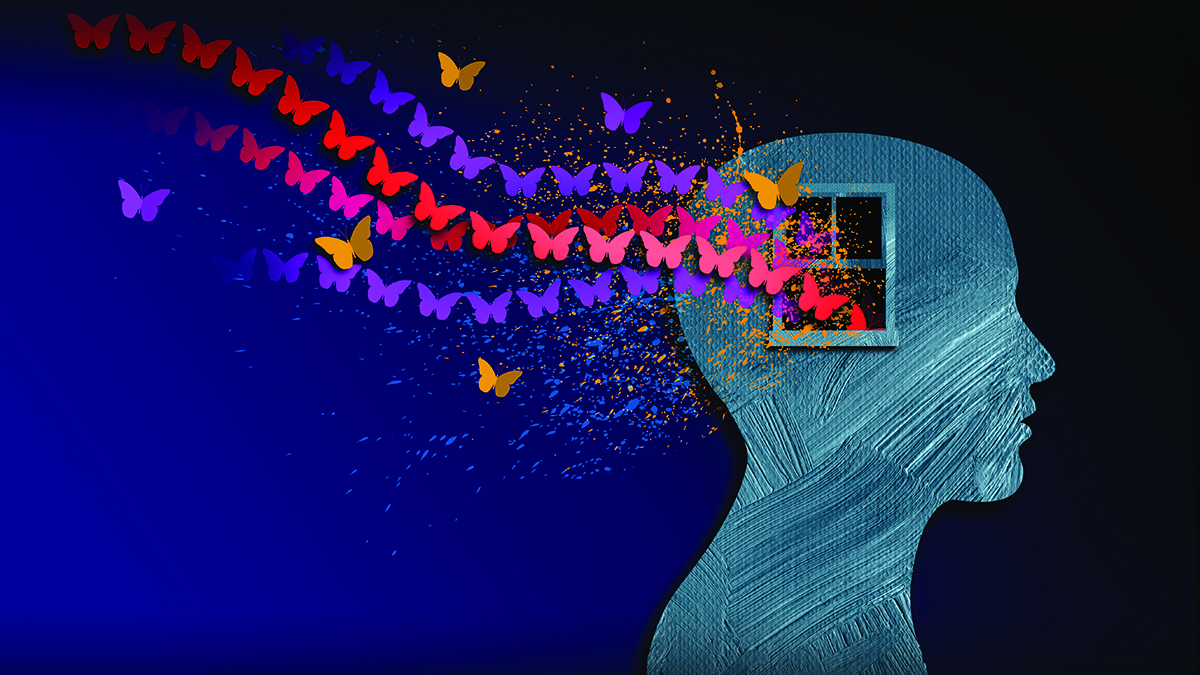
Every day we design amazing science learning opportunities for our students that include activities like demonstrations, hands-on experiences, and inquiry-based investigations. Yet many students struggle deriving evidence-based scientific explanations from those rich learning experiences. Without a plan, opportunities for teachers to see their students’ thinking during hands-on activities is limited. When students write in science, they create windows into their thinking—windows teachers can use to assess and monitor their students’ emerging scientific explanations about the rich science learning experiences teachers provide.
There are many vehicles for incorporating writing into science instruction (e.g., letter to a stakeholder or policy maker, advanced note-taking strategies, creative nonfiction writing, and so on). The instructional model Claim, Evidence, and Reasoning (CER) (McNeill et al. 2006) was first proposed as a framework to help students develop explanations of scientific phenomena by developing claims and connecting them to supporting evidence. This emphasis on the value of students developing scientific explanations is recognized both nationally by the National Science Teaching Association (NSTA) and Next Generation Science Standards (NGSS) and locally among the science teachers that participated in Project LISTO. Eleanor, a fifth-grade science teacher serving a rural community shared, “As a science teacher, few things beat a high-quality scientific explanation from a student. However, the frequency of such explanations often seem [few and] far between.” Another rural science teacher, Brenda, lamented her students’ scientific explanations that could hardly be described as more than a string of scientific terms loosely pooled into ambiguous sentences scribbled between the pages of a science notebook. These experiences strike a familiar chord to those of us working with elementary students. To this end, this article is organized around describing a pair of resources developed to support student and teacher use of CER in the classroom and incorporate writing as a meaningful part of their science instruction. We developed and put the Scaffolding Scientific Explanations (SSE) resources in the hands of teachers across Texas to help alleviate writing challenges common to typical science classrooms.
Scaffolding Scientific Explanations
Taking part in the scientific process of inquiry and investigation is only one step toward understanding science. Students also need to be able to make sense of their observations and connect them to the science content being learned. One way to help students see those connections is by providing opportunities to write a reasoned explanation about a specific topic.
Forty teachers from across Texas utilized CERs as a structured opportunity for students to write scientific explanations paired with hands-on learning experiences. Part of the inquiry process is the development of writing scientific explanations that utilizes appropriate evidence to support student claims and reasoning. There can be a steep learning curve as students work toward developing logical explanations. Each compounding layer of expectation has the potential of pushing students beyond where they are comfortable performing without assistance. This can lead a student to a level of cognitive frustration. To assist in supporting student writing, we developed a Scaffolding Student Explanations (SSE) handout to provide scaffolded writing opportunities to fifth-grade students.
Eighty-three percent of the participating teachers had little to no experience using CERs. Additionally, teachers reported overall low writing abilities among their students. Sentence stems, writing prompts, and graphic organizers strengthened the writing skills and confidence of our participating students. These prewriting scaffolds were integrated into our SSE handout and included in six of the 15 units in Project LISTO’s curriculum. Each SSE had four parts: (1) claim, (2) evidence, (3) reasoning, and (4) key terms and vocabulary, as reflected in Figure 1. Over the course of the academic year, the level of scaffolding provided to students in three of the four sections decreased over time, the exception being the reasoning section, which younger students commonly struggle constructing.
In this highly scaffolded version of the SSE handout (see Figure 1), students were provided with four circuits—examples that reflected the circuits they worked with throughout the unit on electricity and electrical circuits. The first section, Claim, rephrases the guiding question at the top of the handout into a fill-in-the-blank opportunity. Students would write the letter of the circuit they felt best represented a “complete circuit.” The second section, Evidence, was also highly structured; the students were given not only a specific activity to revisit in their science journal but also provided some of the key questions from that activity that would help them draw out relevant data from their notes. The third section, Reasoning, provided them with an opportunity to document which circuit they chose in the first section but also provided a highly scaffolded checklist option for them to construct their final reasoning statement. While there were some distractor items in the checklist, many described specific aspects of different types of circuits the students would have worked with throughout the unit. Finally, to support students in their use of scientific vocabulary in their final narrative, we included eight words grouped in pairs based on their relationship to one another. Teachers could use this to encourage their students to strive to include a specific number of relevant scientific terms in their explanation. At this highly scaffolded level, many teachers would support students transforming the information from the SSE handout into a narrative by eliciting student input as they formed a class scientific explanation to be recorded in each students’ science notebook.
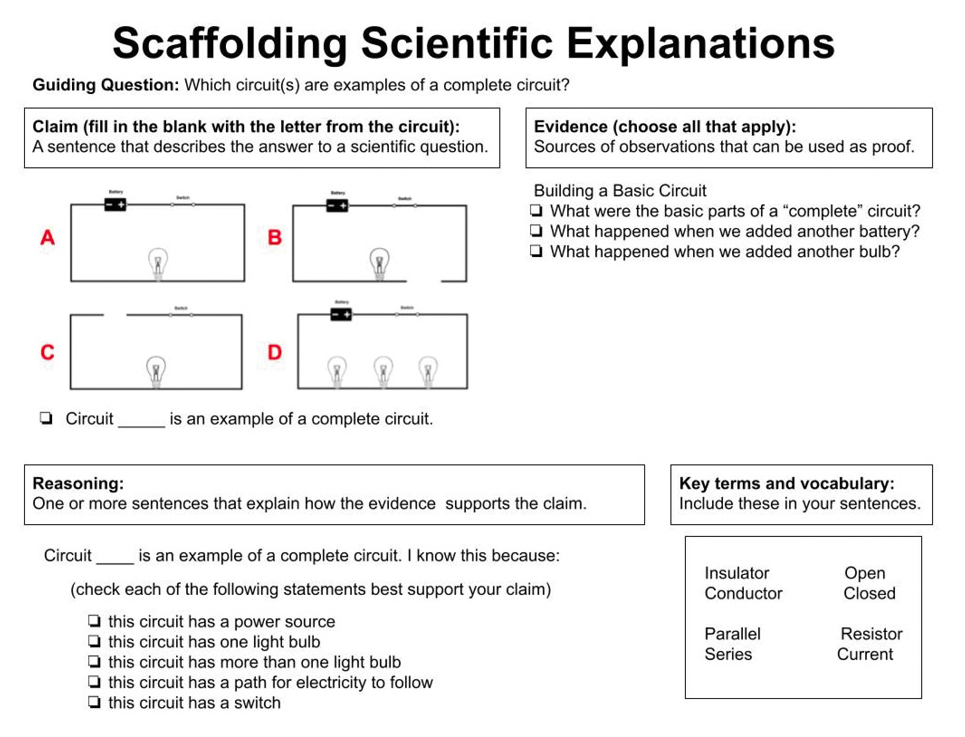
Scaffolding scientific explanations (SSE) handout.
Scaffolding the SSE Handout
When teachers in our project began to incorporate the SSE handout into their curriculum, they found the writing ability of their students varied. Several teachers noticed students struggled with organizing their thoughts and there were gaps in their understanding of grammar (i.e., complete sentences, capitalization, punctuation). Elizabeth, a fifth-grade urban science teacher mentioned “After checking some of the students’ writing samples, I noticed that some of the students were struggling with the writing process. Not only did they lack organization skills but also sentence structure. Most of my students are second language learners and they are at different writing levels.” Ethan, a fifth-grade rural science teacher stated “Prior to the units that had a CER, I had very little knowledge about my students’ ability to write effectively. When we did our first CER, most of the students...required not only sentence stems but also a lot [sic] of help building on the acquired knowledge from the lesson.” To this end, the Project LISTO team developed a scaffolding map for the SSE handout (see online Table 1).
The scaffolding map was organized by the three primary sections of the SSE handout (Claim, Evidence, and Reasoning). The scaffolding map provided specific samples for four levels of decreasing scaffolding opportunities culminating in the final column of student independence. The intent of this resource was to support teachers as they looked to differentiate their level of support to help students form scientific explanations. As teachers worked on a specific area of the SSE handout, they could scale back the level of scaffolding in that area without having to scale back support on the whole resource. For example, Figure 2 and Figure 3 illustrate two more samples of SSE handouts that have been scaffolded for students at different places in forming scientific explanations. In Figure 2, the student is provided with a place to choose which geographic feature has had the most impact on one of a list of cities that they had been collecting weather data on throughout the unit on weather and climate. This support requires more effort on the part of the student without pushing them to the cognitive level of generating a claim out of thin air. Additionally, the evidence section has been expanded to include a series of different learning experiences throughout the unit and provides students with a chance to determine which data source(s) is most relevant to the claim they proposed. As was common among our participating science teachers, the reasoning section always remained highly scaffolded. In this example, the scaffolding was designed to help them organize their use of language to present the justification for their claim.
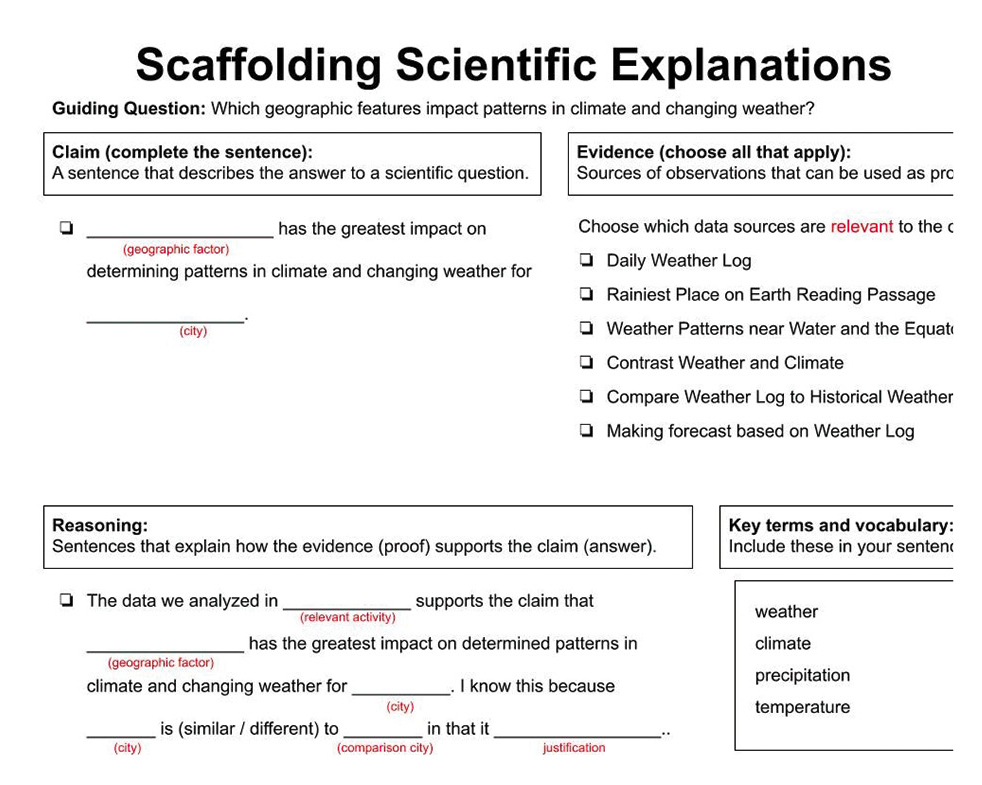
Sample of SSE Handout: Weather and Climate.
Figure 3 reflects an SSE handout that would support students who had mastered transforming a guiding question into a claim but may still need support on choosing relevant sources of data from their science notebook. In this example, you’ll see a similar level of scaffolding as the initial electrical circuit example in that we provided the activity and specific questions to help students focus on the relevant information from that experience. The only key difference is that they are provided with two experiences instead of one. This level of scaffolding provides students with an opportunity to synthesize their understanding across two separate learning experiences. As with both previous examples, you will notice unit-specific language used to provide a structured opportunity to form a reasoning statement. The variation in this handout is that students can choose from among three different ways you could appropriately phrase your reasoning statement depending on your claim and source of evidence.
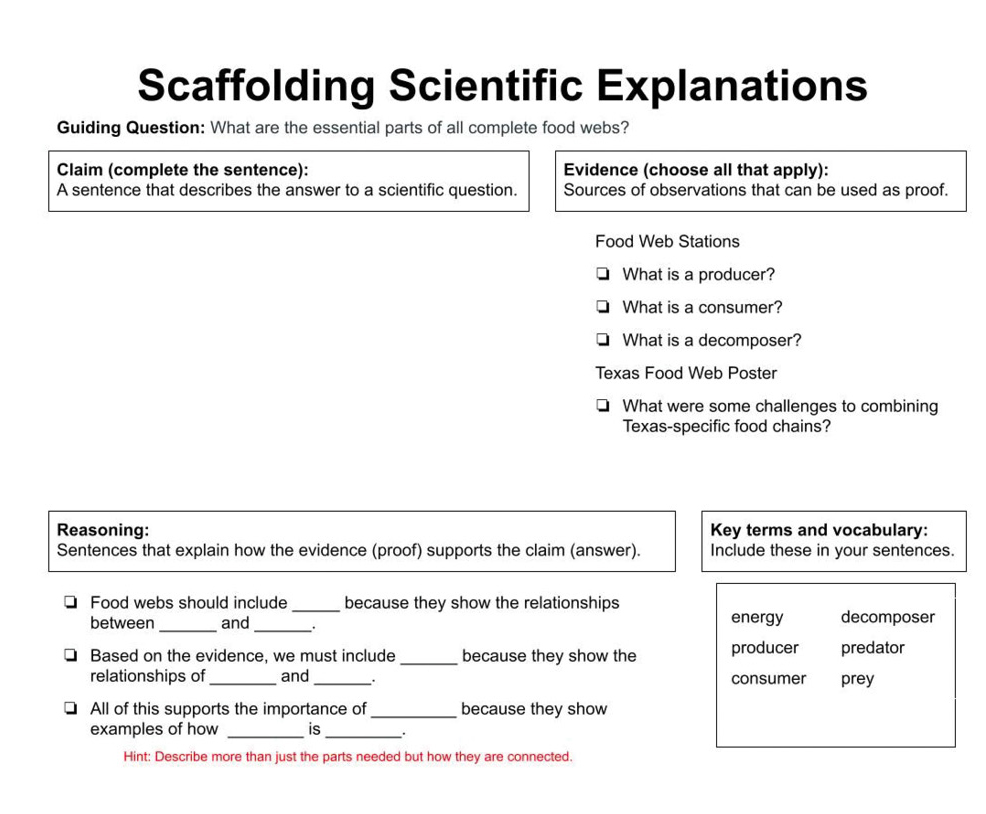
Sample of SSE Handout: Food Webs.
Scaffolds by nature should be just enough support to help the students stay engaged with the key learning objective without taking away the student’s ownership of their own learning. As such, the SSE handout included opportunities for five levels of scaffolding, highly scaffolded to no scaffolds, in each of the three main CER components (Table 1). While Project LISTO strategically adjusted the level of scaffolds on the student handouts by unit, teachers were encouraged to adjust the level of scaffolding for individual students based on their need.
Transitioning From Graphic Organizers to Writing
Writing is a cognitive process that provides students with opportunities to carefully select words and create a structure that organizes student thinking about scientific concepts. The challenge is to shift the way we use writing in science from recording information to making critical connections and expressing critical thinking about scientific ideas and observations. The SSE handout was designed to assist teachers in incorporating writing into their science lessons and provide a pre-writing tool for students to brainstorm ideas for each step of the CER framework. Pre-writing tools such as graphic organizers help students visually organize the information, but it should not be the end product. Once students filled in each section of their graphic organizer, the SSE handout, teachers modeled how to transfer their ideas and statements into a narrative paragraph. Figure 4 is an example of a student’s completed SSE handout paired with their narrative scientific explanation for a unit on food webs.
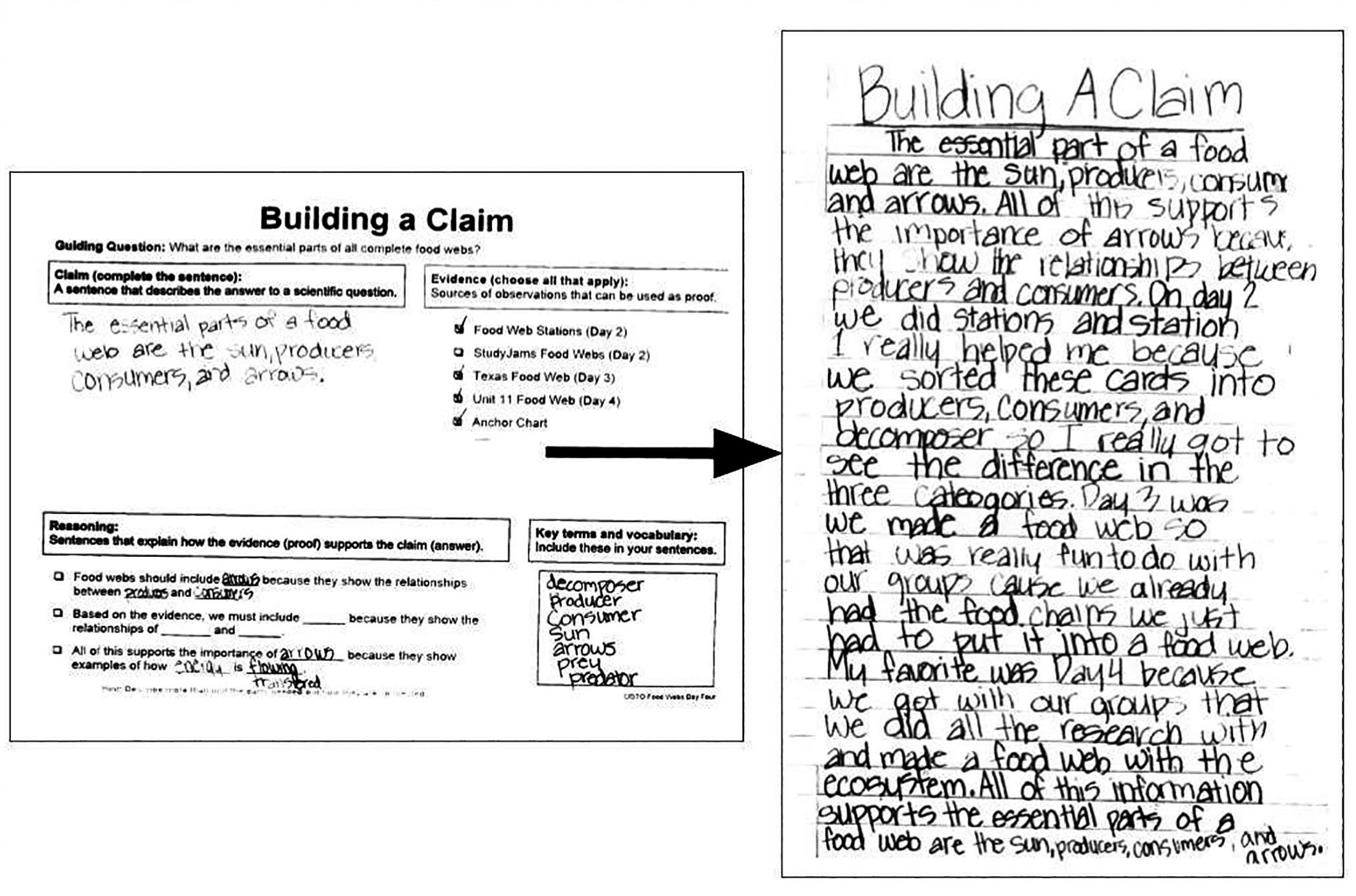
Completed student sample of SSE handout and paired scientific explanation.
At the beginning of the year, this process was highly scaffolded by the classroom teacher—many times to the point of generating a class “scientific explanation” and then recording it in their science notebook. Some teachers, like Hannah, a fifth-grade science teacher in an urban environment, found that their students were more active contributors to the class science explanation as the year progressed. “... the first CER was a challenge… [I] had to provide a lot of probing questions and model how to complete the stems and thinking process. However, by the third CER, we were on a roll. I still guided the activity, but the students were providing the ideas and evidence.” Mary, another fifth-grade science teacher in a rural community, found that as the year progressed, the familiarity of the SSE structure allowed her to exercise more of a gradual release to the students to develop their narrative scientific explanation: “I found as the year progressed, when a CER came along, my students were a little more familiar with the process. It took less explanation to get [through] the writing.” In Mary’s classroom, she realized for her students to be successful she needed to utilize explicit or direct instruction to guide students through the CER process, which is one of the recommendations from the U.S. Department of Education (Graham et al. 2016).
Benefits of the SSE Handout
Our experience working with teachers and students has taught us that guided inquiry or hands-on opportunities are foundational instructional activities for sensemaking in science. Young science learners struggle to find ways to organize their observations in meaningful ways. When teachers organize student learning around science investigations, it creates opportunities for students to develop meaningful connections between concepts, prior experiences, and physical and social interactions (NASEM 2019). Sean, a fifth-grade science teacher serving in an urban community described the benefits of using the SSE handout to help his students organize their thoughts into a written explanation, “It helped my students understand the concept more. They were able to take ownership of the claim and respond to it using their own words. It helped them clarify their ideas.” To share a scientific explanation in writing pushes the writer to think more comprehensively about their observations and to exercise a higher level of academic language use.
We surveyed our participating teachers at the end of our year of implementing CERs and the SSE handout. Teachers reported that these writing scaffolds increased their students’ use of science vocabulary (77%), helped their students formulate more complete sentences (61%), and improved their students’ ability to provide detailed explanations (41%). Nancy, a fifth-grade rural science teacher described the benefits her students received from using the SSE handout to support scientific explanation, “The value of having students write CERs is that the scientific process is more evident in their responses but also to have them truly become inquisitive and not give up in finding a solution or reason for why it happened.”
Conclusion
Time is a finite resource and often a priority consideration when teachers develop instructional opportunities for their students. In the most recent National Survey of Science and Mathematics Education (Smith 2020), only 35% of science teachers in grades 4–6 taught science all or most every day of the school week, with an average of 27 instructional minutes per day (Smith 2020). Many science teachers feel considerable pressure to justify choices in how they allocate this valuable commodity. Dedicating time to talking and writing as part of the sense-making process is often sacrificed to the fast-paced cycle of direct teaching and demos.
Providing budding scientists with the opportunity to make connections between inquiry-based investigations and written scientific explanations is an integral component of science literacy. However, many science educators see scientific explanation as a rigid product that requires advanced critical thinking skills—skills some perceive not yet accessible by younger learners. Young learners can practice age-appropriate reasoning considered beyond their capacity when provided “carefully constructed conditions of support” (NASEM 2015, p.30). Learners need support from teachers—some of which can be facilitated through explicit instruction and writing scaffolds. Project LISTO found that teachers’ use of the Scaffolding Scientific Explanations (SSE) handout improved student writing ability and allowed teachers to see student thinking. The SSE handout is one more tool for a teacher to strengthen students’ ability to construct evidence-based explanations. ●
Kenneth Fleming (kennethflemingjr@tamu.edu) is an educational consultant with Science Between the Pages and an adjunct faculty member at Texas A&M University in College Station. Allison Esparza is a research specialist and doctoral student, Beverly Irby is a regents professor and senior associate dean for Academic Affairs, Rafael Lara-Alecio is a regents professor, Fuhui Tong is a professor and department head, and Cindy Guerrero is a research scientist, all at Texas A&M University in College Station.
Inclusion Interdisciplinary Literacy Teaching Strategies Elementary


